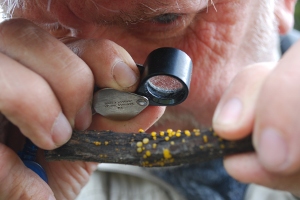The YPOQ segments are some of my favorites. But to be honest, it’s getting harder and harder to find photographers who are doing something unique. Being one of the newer members of the QUEST team, I decided to go back to some of the Flickr sets we received before I got here, and find out what those photographers are up to now.
There, I found Ron Wolf’s photostream. As it was the middle of winter, I was surprised to see that his photos were taken recently, until I realized that I was looking at the fruits of the California winter. All of his recent images were of mushrooms and slime, and surprisingly QUEST had not broached this topic yet.
I know, I know, slime and fungi – seen it, ignored it, they’re gross, right? Wrong!
I really had no idea there is such a plethora of fungi here in the Bay Area, and I’ve never looked closely at a slime mold before. Now, after spending the day with Ron Wolf, I doubt I’ll ever look at the ground the same way anymore!
Fungi (to which both mushrooms and slime belong) are found worldwide, and most are inconspicuous due to their small size, and their cryptic lifestyles in soil and on dead matter. But fungi perform an essential role in the natural cycle of our environment.

"They’re a major factor in decomposition of wood and plant matter," says Ron Wolf. "I mean, the reason the planet is not 20 or 40 or 50 feet deep in leaf litter and dead wood and all the rest is the process of decomposition and digestion of this organic matter. And that’s a function of fungi.”